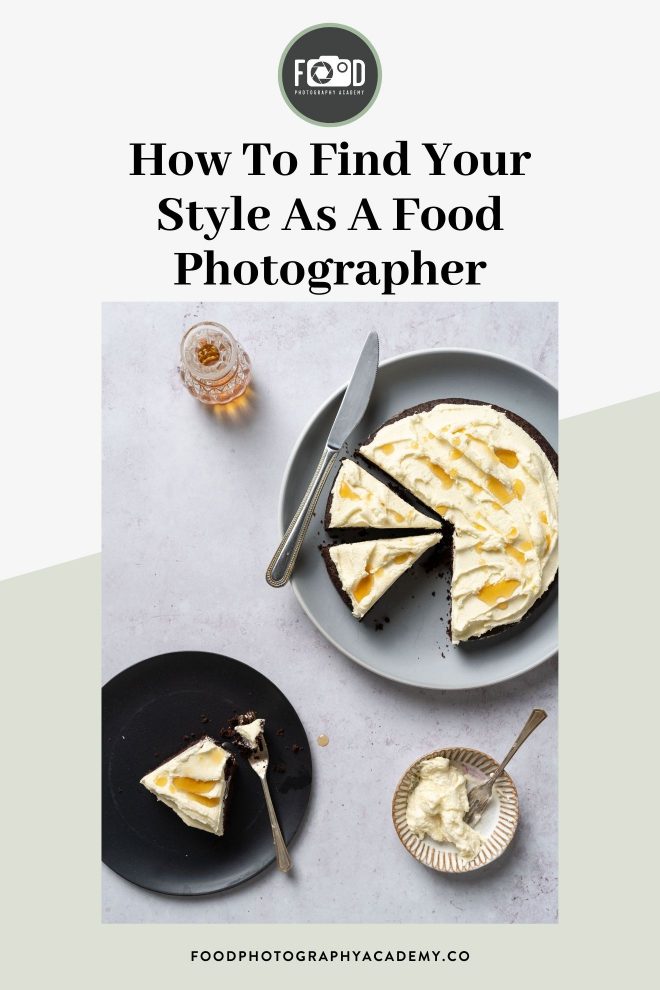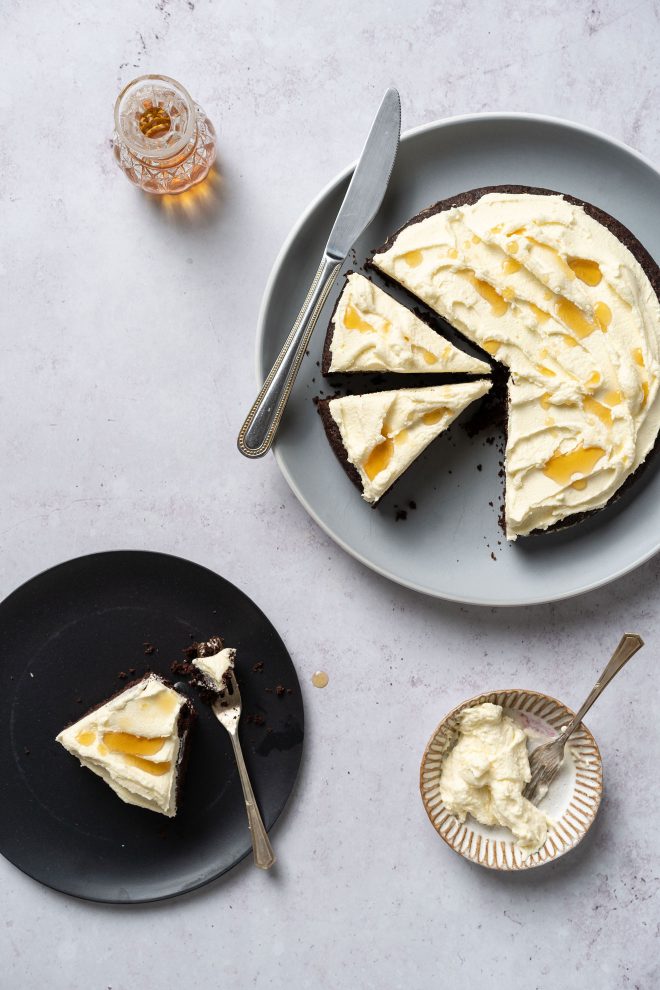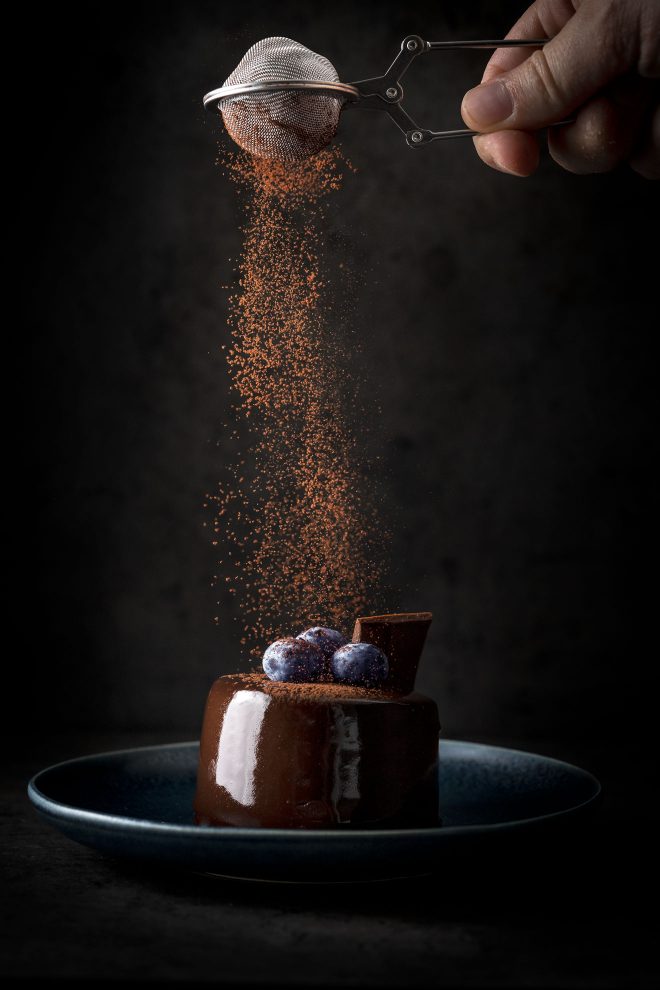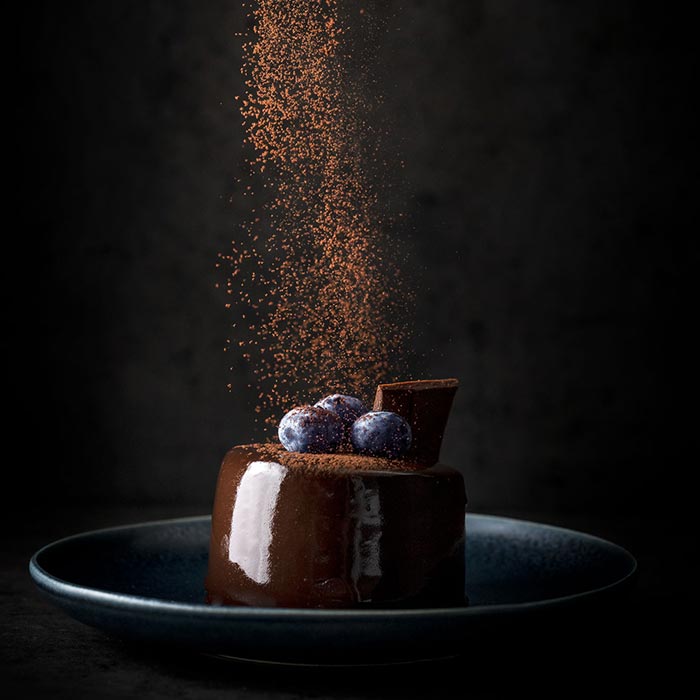Look at the work of a photographer you admire, and you’ll probably notice that they have a distinct and instantly recognisable style. In fact some photographers have such an easily identifiable look that you can tell their work from a mile off, helping to set them apart in the crowded photography market.
Want to stand out from the competition, but unsure how to find your own food photography style? Read on.

Why Develop a Personal Photographic Style?
The primary advantage of developing a distinct food photography style is that you will become easily identifiable and more memorable in the minds of prospective clients and the general public alike. This can only help to raise your profile.
But knowing this is one thing; achieving it another. In fact, at the beginning of your career, understanding how to find your photography style can seem like a real challenge.
It needn’t be though, and in this article I’ll explain the techniques that have worked for me in finding my own personal style as a food photographer.
Before we get to that though, I want to consider just how deep a photographer should really go in developing a unique look. Does there come a point where having a too clearly defined style can actually hold you back as a photographer?
Just how niche should you get? Let’s weigh up the arguments.
Argument 1 – Your Photographic Style is Your USP
There are perhaps more pro photographers in the world right now than ever before; all competing for the same jobs, from the same clients. This makes it a buyer’s market.
But with so many talented and highly skilled photographers to choose from, how does a client decide who to work with? For sure, costs, professionalism, and personality will play a big part; but the style of a photographer’s work will undoubtedly be the deal-clincher.
To put things bluntly, if you don’t have a clearly recognisable style, there’s no particular reason for a client to choose you over the hundreds of thousands of other photographers you’re competing against. In today’s globalised photography market, only those photographers with something different to offer will stand out from the ocean of mediocrity.
Related: Creating A Food Photography Narrative
Not only that, but more experienced clients usually won’t waste time looking for just any food photographer to do their next shoot. Instead they will likely have a clear idea of the kind of photographic treatment the job requires, and will only shortlist photographers who are known for producing a style of photography that closely coincides with their brief. If that’s you, then the job might just be yours. If it’s not, you won’t even get a look in – no matter how talented and professional you may be.
In short, your photographic style is your Unique Selling Point, helping to make you more memorable, and permitting you to “own” a particular section of the market. Without it, you’re just another jack-of-all-trades, indistinguishable from the camera-wielding hordes.
At least, that’s how one argument goes.
Argument 2 – Power in Diversity
On the flipside, some food photographers go too far, to the point that every photo they shoot just looks the same. And shooting the same style again and again can quickly become boring: boring for you; boring for your clients.
Not only this, but by over-specializing there’s the risk that you back yourself into a corner, ruling out a lot of potential work. Think about it: you might have developed a really unmistakable and highly original approach to food photography, but if it’s too distinctive it likely won’t be right for 95% of the market. And even those clients who love your style need to maintain customer engagement, so there’s a limit to how many times they will be able to make use of your services before having to change things up.


Both of these images of mine are of chocolate cakes, but in completely different styles. My personal approach has been to develop my skills in a few different styles, becoming a skilled photographer in all of them.
A lot of clients like to find a photographer who they can develop a longterm relationship with. If you consistently deliver good results, they’ll keep coming back with more work. A client will only be able to do this though if you are a well-rounded photographer who can cover a broad range of styles in order to meet their ongoing needs. These needs may change over time.
As an example, if you are known as the uncompromisingly “dark food photographer,” a client may get excited about this the first time round, if it fits with their requirements for that particular shoot. But if next time the brief is on a more light and airy vibe, don’t expect to get called back again, no matter how satisfied the client may have been with the previous shoot. Now the job will either go to someone who specializes in this particular look, or to a more versatile photographer who is able to shoot any food photography style on-demand.
Which Kind of Photographer Are You?
The two arguments we’ve just looked at are not binary opposites, so much as the end points of a continuous arc: when it comes to deciding how versatile or specialized they want to be in their photography, different photographers will find that they fall at hugely varying positions along this line. Neither point of view is right nor wrong, and in reality many photographers will sit roughly half way between the two extremes.
For some photographers, overly-specializing by developing a very niche style could be commercial suicide. This is particularly the case for those working within a limited geographical region, with only a small number of potential clients. But in order to stand out and get noticed, photographers pushing their services to a much bigger pool of potential clients – those targeting a major national or international market, for example – will likely find it essential to develop a unique and specialised photographic style.
There’s also your own personality to consider. For some people – particularly those photographers who enjoy a technical challenge – shooting the same style again and again just wouldn’t be very stimulating. For others – perhaps those with a more artistic temperament – the idea of chopping and changing their style purely to please clients may feel quite inauthentic.
In short, whether you should develop an entirely unique and idiosyncratic look or instead strive to be a more well-rounded and versatile photographer will depend on both your own personal disposition and the type of photographic market you work in.
How to Find Your Food Photography Style
Already decided that developing a strong personal photographic style is the right move for your career? Great! But how exactly? These are the steps that have worked for me.
Shoot More and Shoot Wide
Don’t commit to anything too early on: sometimes what we at first think of as our photographic “calling” may turn out just to have been a passing phase. Instead, an original and convincing photographic style usually develops quite organically and naturally over time. This will only happen if you are open to experimenting with a whole range of styles and techniques at the start of your career.
Related: 6 Creative Photography Ideas To Freshen Up Your Style
Shoot a lot, and in a variety of styles, so you can discover what works best for you. Over time you’ll likely find that different elements of all the diverse styles and techniques that you’ve tried out will creep back into your photos quite naturally, until you fuse them into something original entirely your own.
Profit From Your Mistakes
Penicillin was famously discovered almost by accident when the scientist Alexander Fleming came across a Petri dish that had been contaminated by bacteria from an open window. Photography, too, can be full of happy accidents: you may not invent a life-saving form of antibiotic, but often the core of a photographer’s personal style will come out of serendipitous discoveries of exactly this kind.
Stay open to your mistakes, think about what might happen if you repeat them in a more controlled manner. Make a mistake once; you’re human. Make it twice; you’re clumsy. But make it three times, and you’ve got a photographic style.
Look Within
Although all photographers take inspiration from their heroes, those who develop a truly distinctive and original photographic style will usually have spent just as long looking within themselves for inspiration as they have studying the work of their peers. In fact, look at any photographer with a particularly fresh, strong, and convincing photographic style, and you’ll usually find that their photographs are a clear extension of their personality.
Photos cold, dark, and mysterious? The photographer might not be an outright cynical doom-merchant in real life, but you can be pretty certain they won’t be the life and soul of the party either. Light and flowery photos instead? They’re probably not the work of that EMO/goth kid standing alone in the corner.
Whatever your interests, personality, and obsessions (from the weirdest to the most mundane), try to explore these through your photography. Just as these are the things that make you you, they are also the things that will make your photography yours.
Look Beyond
With that said, it’s also important not to get too self-indulgent, so be sure to keep your eyes open for outside influences as well. Obviously it’s essential to look at the work of other photographers, but try to go beyond the confines of photography too.
A creative photographer will take influences from movies, painting, installation-art, graphic design, comics; basically any form of visual art. But don’t stop there; look for inspiration in literature, dance, science, philosophy, the supernatural – or indeed anything that you personally find interesting.
Analyse and Condense
A photographer’s personal style usually develops naturally over time, simply from shooting and experimenting. However, you can speed up this process by thinking about it in a proactive way. True, a photographer who forces a personal style will likely come across as a little bit fake, and their style is likely to change dramatically a few times before they really find their “true” self photographically speaking. But photographers who are conscious of what they are doing, and who actively try to analyse both their own photos and those of others, will likely progress much faster here.
One of the best ways of achieving this is to keep a creative workbook, Pinterest moodboard, or folder of favorite images: photos, paintings, even lines from poems or novels, whatever. Alongside these diverse sources of inspiration you should probably also include examples of your own work – both favorite shots and ones that didn’t quite work out but that nonetheless show some spark of an idea that you might want to develop further in the future.
But it’s not enough just to throw these sources of inspiration into a folder and forget about them. Instead study them frequently, asking yourself what it is about each of them that you find exciting or intriguing. Write down a list of adjectives that describes each one. Why do they attract you? The mood? The composition? The lighting? Edit this list down until you’ve got a strong, condensed group of adjectives that together conjure up a distinctive atmosphere.
Think about how you can make images of your own that give-off a similar vibe or communicate these same emotions. Now you’ve found your food photography style.

Hi Lauren,
First of all thanks for this site. I’ve started exploring it this week and found it truly inspiring. I’m starting with food photography, so I might stay here for a while.
Regarding the photographic style, would it be right if I set my style according to a restaurant’s brand, niche or vibe?, assuming that the photographic style from traditional Greek dishes could be different from food images of a resto bar or lounge restaurant
Thanks
Cristian
THANK YOU!
Hi
wow! get a great inspiration.
You’re welcome Tahrim